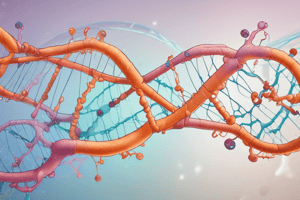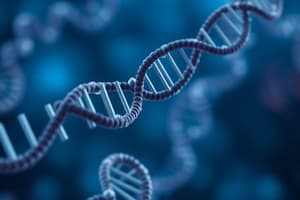Podcast
Questions and Answers
What is the primary function of ribonucleoproteins (RNPs) in eukaryotic cells?
What is the primary function of ribonucleoproteins (RNPs) in eukaryotic cells?
- To facilitate the translation of mRNA into protein
- To transcribe DNA into RNA
- To protect RNA from degradation and facilitate recognition (correct)
- To replicate DNA during cell division
What is the significance of the code written in RNA in the form of chemical modifications?
What is the significance of the code written in RNA in the form of chemical modifications?
- It increases the stability of the RNA
- It enhances the transcription rate of RNA
- It facilitates the binding of RNA to specific proteins (correct)
- It determines the secondary structure of the RNA
What is the purpose of the caperuza structure in RNA transcribed by RNA pol II?
What is the purpose of the caperuza structure in RNA transcribed by RNA pol II?
- To enhance the stability of the RNA
- To protect the RNA from degradation by Rat1 (correct)
- To increase the transcription rate of RNA
- To facilitate the translation of mRNA into protein
What is the difference between RNPs in eukaryotic and prokaryotic cells?
What is the difference between RNPs in eukaryotic and prokaryotic cells?
What is the function of the spliceosoma in RNA processing?
What is the function of the spliceosoma in RNA processing?
What is the primary function of RNA tools?
What is the primary function of RNA tools?
In what type of RNA do we observe the formation of RNPs?
In what type of RNA do we observe the formation of RNPs?
Which of the following types of RNA do not undergo modifications?
Which of the following types of RNA do not undergo modifications?
What is the primary difference between procariotas and eucariotas in terms of RNA modification?
What is the primary difference between procariotas and eucariotas in terms of RNA modification?
What is the main purpose of classifying RNA modifications?
What is the main purpose of classifying RNA modifications?
What type of bond is formed between the guanine nucleotide and the first nucleotide of the pre-mRNA?
What type of bond is formed between the guanine nucleotide and the first nucleotide of the pre-mRNA?
What is the function of the metiltransferase enzyme during cap formation?
What is the function of the metiltransferase enzyme during cap formation?
What is the role of the CTD in the formation of the cap structure?
What is the role of the CTD in the formation of the cap structure?
What is the purpose of the cap structure in eukaryotic mRNA?
What is the purpose of the cap structure in eukaryotic mRNA?
What is the function of the NAD cap in some eukaryotic RNAs?
What is the function of the NAD cap in some eukaryotic RNAs?
What is the primary function of TUTases in RNA metabolism?
What is the primary function of TUTases in RNA metabolism?
What is the purpose of introducing poly-A tails in mRNAs?
What is the purpose of introducing poly-A tails in mRNAs?
Which of the following RNAs does not have a poly-A tail?
Which of the following RNAs does not have a poly-A tail?
What is the function of exonucleases in relation to TUTases?
What is the function of exonucleases in relation to TUTases?
What is the consequence of forming a poly-U tail after a poly-A tail in some mRNAs?
What is the consequence of forming a poly-U tail after a poly-A tail in some mRNAs?
What is the primary function of spliceosomes in RNA processing?
What is the primary function of spliceosomes in RNA processing?
What type of RNA editing involves the insertion or deletion of nucleotides?
What type of RNA editing involves the insertion or deletion of nucleotides?
What is the primary function of microRNA in RNA interference?
What is the primary function of microRNA in RNA interference?
What is the consequence of alternative splicing?
What is the consequence of alternative splicing?
What is the primary function of editases in RNA editing?
What is the primary function of editases in RNA editing?
What is the purpose of the RNA-induced silencing complex (RISC) in RNA interference?
What is the purpose of the RNA-induced silencing complex (RISC) in RNA interference?
What is the primary function of splicing factors in RNA processing?
What is the primary function of splicing factors in RNA processing?
What is the purpose of small interfering RNA (siRNA) in RNA interference?
What is the purpose of small interfering RNA (siRNA) in RNA interference?
What is the primary function of RNA interference (RNAi)?
What is the primary function of RNA interference (RNAi)?
What is the consequence of RNA editing?
What is the consequence of RNA editing?
What is the primary function of the large 60S subunit in eukaryotic cells?
What is the primary function of the large 60S subunit in eukaryotic cells?
What is the role of initiation factors (eIFs) during translation initiation in eukaryotic cells?
What is the role of initiation factors (eIFs) during translation initiation in eukaryotic cells?
What is the outcome of the two transesterification reactions catalyzed by the spliceosome?
What is the outcome of the two transesterification reactions catalyzed by the spliceosome?
What is the sequence of events in protein synthesis in eukaryotic cells?
What is the sequence of events in protein synthesis in eukaryotic cells?
What is the purpose of capping and polyadenylation during mRNA processing in eukaryotic cells?
What is the purpose of capping and polyadenylation during mRNA processing in eukaryotic cells?
Flashcards are hidden until you start studying
Study Notes
Types of RNA Processing
- RNA undergoes modification during or after transcription, which is essential for understanding its function
- There are three subgroups of RNA:
- RNA that carry information (mRNA)
- RNA tools (tRNA, rRNA, snRNA)
- Non-coding RNA (not studied in detail)
Modifications of RNA
- Modifications can be classified by type and in which RNA molecule they occur
- Modifications can occur in both prokaryotes and eukaryotes
- The table shows modifications of RNA precursors, with the last column added later to show the formation of RNP, which is essential for RNA function
RNPs in Eukaryotic Cells
- Ribonucleoproteins (RNPs) are stable associations between proteins and RNA
- In eukaryotic cells, RNA is never bare, but associates with proteins to protect it from degradation and for recognition
- RNPs are formed in the nucleus before transporting to the cytoplasm
- Proteins can exchange with others in the cytosol, resulting in different proteins bound to the RNA
mRNPs in Eukaryotic Nucleus
- The association of RNA with proteins provides information about its fate
- RNA modifications can be read by proteins, which then bind to the RNA
- The code is written in the RNA as chemical modifications, which are read by proteins and specific binding occurs
- Readers of the code include degradation machinery, transport machinery, spliceosomes, and translation machinery
Capping of RNA
- The cap is a structure that associates exclusively with RNA transcribed by RNA polymerase II
- If the cap is not added, the primary transcript is rapidly degraded
- The cap is a guanine nucleotide that is "in reverse" and is resistant to degradation
- The process of capping involves phosphatases, guanylyltransferases, and methyltransferases
Role of CTD
- The enzymes involved in capping are attracted to the CTD tail of RNA polymerase II, which is phosphorylated on serine 5
- The binding of enzymes to the CTD tail is important, as it accelerates the reaction rate
- The enzymes are released once the serine 2 is phosphorylated
NAD Capping
- Recently discovered: NAD capping in mRNAs, where NAD is a dinucleotide (A linked to nicotinamide)
- NAD is added to the end of a messenger by a phospho-phospho bond
- In prokaryotes, NAD is not added later, but RNA polymerase uses NAD as the first nucleotide instead of ATP
- The modification is a signal for the cell to read and degrade the RNA in a specific way
Poly (A) and Poly (U) Tails
- Poly (A) tails are found in the other end of transcripts, and are only introduced in messengers (except for histone messengers)
- The introduction of poly (A) tails is a mechanism of transcription termination
- Poly (U) tails are introduced by the TUTase enzyme, which is a writer that marks RNA for degradation
- Poly (U) tails can be introduced in RNA that did not have a tail previously, such as histone mRNAs
- The degradation of RNA with poly (U) tails is dependent on uridinilation
Studying That Suits You
Use AI to generate personalized quizzes and flashcards to suit your learning preferences.




